Understanding Your Pain
Nociceptive Pain Neuropathic Pain Inflammatory Pain Musculoskeletal Pain Referred Pain Hyperalgesia/Hypoalgesia AllodyniaPain Is Personal
Describing your pain to a healthcare professional (HCP) can be difficult. You may find yourself struggling to explain the level of pain and suffering you’re dealing with. The key is to explain how long you’ve been in pain—and how it’s affecting your daily life. Talk about how often you feel the pain, how long it lasts, and how it impacts your daily activities and relationships with others.
Give your HCP a clearer picture of how you are feeling, and in turn, they can help you understand your pain.
Acute vs. Chronic Pain1
“Acute pain” and “chronic pain” are commonly used terms to help describe the duration of your pain.
What is acute pain?
Acute pain happens suddenly and quickly. The pain is typically sharp. The cause of the pain is resolved and the pain is alleviated—usually within 6 months.
What is chronic pain?
Chronic pain is long lasting, causing discomfort for 6 months or more. Sometimes pain signals in your body continue firing long after the source of your pain has been resolved. The causes of chronic pain, in some instances, can be difficult to determine but can include headache, arthritis, nerve pain, and fibromyalgia.
While acute pain and chronic pain describe the duration of discomfort, they are broken down into more specific pain categores that help define the quality of the pain sensations.
Understanding Different Types of Pain
Your HCP will explore your pain to try to understand its root cause and how it is affecting your body. Both chronic and acute pain include several kinds of pain with different causes. In fact, your HCP may use one of the following terms to characterize your pain.
What is nociceptive pain?
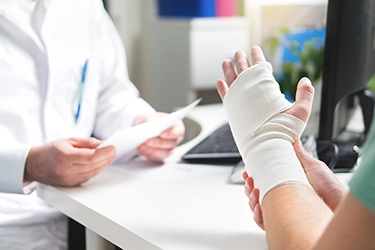
Nociceptive pain is the most common type of acute pain and can result from burns and chemical or traumatic injury.2 The nociceptive pain receptors in our bodies are particularly sensitive to tissue irritation, and send signals to the brain, which, in turn, causes us to feel pain.2
Nociceptive pain comes in one of 2 primary forms: somatic and visceral.3
What is somatic pain?
Somatic pain arises in peripheral tissues (like skin, bone, or muscle).3
What does somatic pain feel like?4
- Localized pain, meaning the pain sufferer can pinpoint the physical location of the discomfort
- Often described as sharp or stabbing pain
What is visceral pain?
- Originates from internal organs (like the gastrointestinal, urinary, and reproductive organs)5
- Diseases commonly associated with visceral pain include irritable bowel syndrome, bladder pain syndrome, endometriosis, kidney stones and gallstones, appendicitis, and chronic pancreatitis—among others5,6
What does visceral pain feel like?
- Often is severe and incapacitating5
- Exact location of pain can be difficult to pinpoint6
What is neuropathic pain?7
Neuropathic pain can be caused by spinal nerve inflammation or compression, or from nerve damage after a surgery or injury.
What does neuropathic pain feel like?
Symptoms of neuropathic pain can include:
- Burning
- Tingling
- “Pins and needles” sensations
- Numbness with bursts of shock-like pain
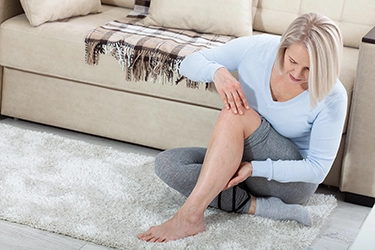
What is inflammatory pain?
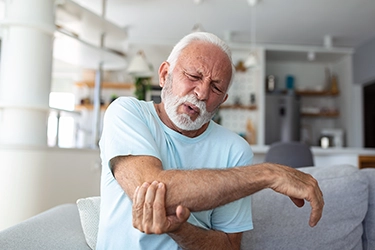
Inflammatory pain is an inflammatory or immune response associated with tissue damage.8 These responses arise due to infection or an autoimmune disease like rheumatoid arthritis.8,9
What does inflammatory pain feel like?
Inflammatory pain is characterized by 5 classic symptoms10:
- Redness
- A heat sensation
- Swelling
- Pain or hypersensitivity
- Loss of function at the pain site
What is musculoskeletal pain?11
Musculoskeletal pain impacts 20% to 33% of the entire population and can be acute or chronic. A wide variety of factors cause musculoskeletal pain, including aging, injury, osteoarthritis, and smoking—and such pain can affect muscles, bones, tendon, ligaments, and nerves.
What does musculoskeletal pain feel like?
Common symptoms of musculoskeletal pain can include:
- Stiffness
- Body aches
- Swelling
- Limited range of motion and mobility
- Nighttime discomfort that can lead to sleep disorders and fatigue
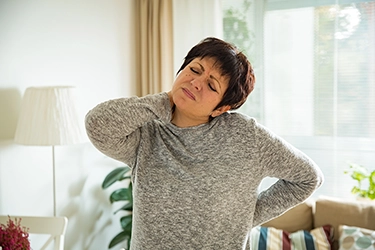
What is referred pain?12

Referred pain is felt at a site other than where the cause of the pain is situated.
Researchers believe that referred pain is the result of the central nervous system misinterpreting the part of the body where the pain stimulus is located.
What does referred pain feel like?
Symptoms of referred pain vary widely according to the part of the body affected. An example of referred pain is a heart attack producing pain in the shoulders or neck.
What is hyperalgesia?
Hyperalgesic pain is much more severe than expected, considering what caused it. In people with hyperalgesia, pain receptors in the body fire more frequently, making the pain much more intense. Repeated pain signals decrease your body’s reaction to them, causing you to feel pain sooner. Even after the incident that caused the pain has passed, people with hyperalgesia will continue to receive pain signals and feel pain after it should have ceased.13
Common causes of hyperalgesia include13:
- Burns
- Migraines
- Infections
- Bites or stings
- Cancer
- Pain syndromes
- Injuries
- Immune or inflammatory diseases
What does hyperalgesia feel like?
The main symptom of hyperalgesia is intense and prolonged pain.12,13
What is hypoalgesia?
Hypoalgesia is a decreased ability to feel pain due to a weakening of nerve fibers and nervous system circuitry.14 Hypoalgesia can pose serious issues because the inability to feel pain can prevent the people from realizing they have health conditions that need attention, leading to delays in receiving important medical treatments.15
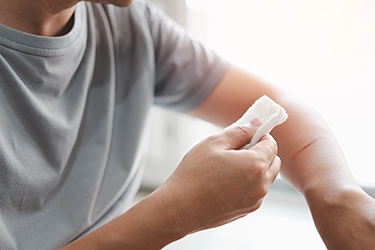
What is allodynia?

Experts believe that allodynia is caused by nerve injury that slows down or blocks certain nerve cells, called inhibitory interneurons, from protecting us from feeling pain from light contact or touch.16 Allodynia can be caused by conditions including17:
- Shingles
- Fibromyalgia
- Migraine headaches
- Diabetes
What does allodynia feel like?
A person suffering from allodynia will feel pain and/or have sensitivity to stimuli that aren't typically painful from a mere touch to hair combing to clothing touching their skin.17
